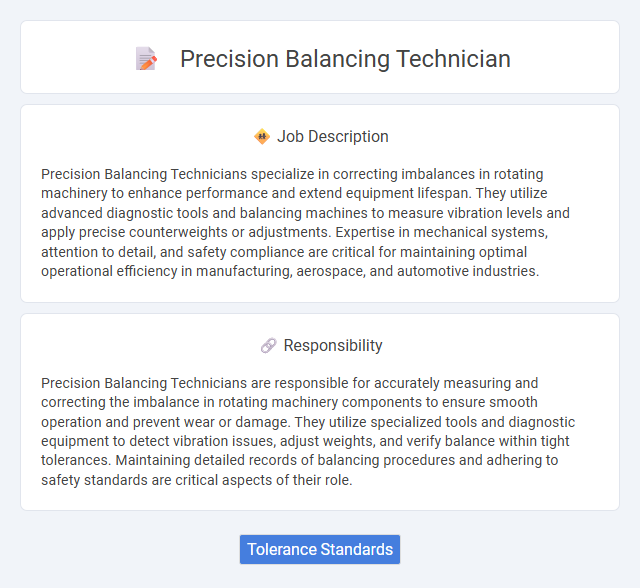
Precision Balancing Technicians specialize in correcting imbalances in rotating machinery to enhance performance and extend equipment lifespan. They utilize advanced diagnostic tools and balancing machines to measure vibration levels and apply precise counterweights or adjustments. Expertise in mechanical systems, attention to detail, and safety compliance are critical for maintaining optimal operational efficiency in manufacturing, aerospace, and automotive industries.
Individuals with strong attention to detail and good hand-eye coordination are likely to be well-suited for a Precision Balancing Technician role. Candidates who prefer working with mechanical systems and have patience for repetitive, precise tasks may find this job fitting. Those who experience difficulty with fine motor skills or lack focus over extended periods might struggle in this position.
Qualification
A Precision Balancing Technician requires strong technical skills in vibration analysis, mechanical systems, and balancing equipment calibration. Proficiency in using dynamic balancing machines and understanding rotor dynamics is essential. Certification in mechanical maintenance or relevant engineering fields enhances job qualification and career advancement.
Responsibility
Precision Balancing Technicians are responsible for accurately measuring and correcting the imbalance in rotating machinery components to ensure smooth operation and prevent wear or damage. They utilize specialized tools and diagnostic equipment to detect vibration issues, adjust weights, and verify balance within tight tolerances. Maintaining detailed records of balancing procedures and adhering to safety standards are critical aspects of their role.
Benefit
Precision Balancing Technicians likely benefit from enhanced machine efficiency and reduced wear by ensuring components are properly balanced. Their role probably contributes to lower operational costs and fewer breakdowns, increasing overall equipment lifespan. This expertise may offer career stability and opportunities for advancement in specialized technical fields.
Challenge
The role of a Precision Balancing Technician likely involves intricate challenges requiring high levels of accuracy and attention to detail. Balancing rotating machinery components may demand frequent problem-solving to address irregularities and maintain optimal performance. Technicians probably face complex diagnostic tasks that test their technical expertise and adaptability under pressure.
Career Advancement
Precision Balancing Technicians specialize in correcting mechanical imbalances in industrial machinery, a skill increasingly vital in manufacturing and aerospace sectors. Mastery of advanced diagnostic tools and balancing techniques opens pathways to roles such as Senior Technician, Operations Manager, or Quality Control Supervisor. Continuous training and certification in vibration analysis and precision measurement technologies significantly enhance career growth and salary potential within the precision engineering field.
Key Terms
Tolerance Standards
Precision Balancing Technicians ensure machinery operates within strict tolerance standards to prevent vibration and mechanical failure. These professionals use advanced diagnostic tools to measure and adjust rotational imbalances, maintaining tolerances often as tight as 0.001 inches or less. Adhering to industry-specific tolerance limits is critical for optimizing equipment performance, safety, and lifecycle.
 kuljobs.com
kuljobs.com